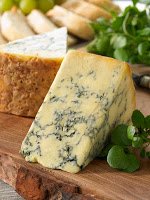Mince pies and turkey
are all well and good, but it's the salty tang of Stilton that is the
true taste of Christmas for cheese lovers.
Britain's most famous blue
is the perfect partner for port or Christmas cake, but there's
another reason why it's the cheese of choice over the festive period.
Stilton is in its absolute prime in December because it has been made
with rich summer milk.
Robin Skailes at
Cropwell Bishop Creamery in Nottinghamshire, whose family have been
making Stilton for over 60 years, explains: “The Stilton you eat at
Christmas has been maturing for at least 10 weeks, so was actually
made in September. That's when the cows have been feeding on the lush
pastures of the Peak District all summer, so they are producing the
ultimate milk for making a soft blue cheese just in time for
Christmas.”
Robin and his cousin
Ben Skailes are the third generation of the family to Stilton. Like
their grandfather, Frank, who bought the company in 1949, they are
sticklers for tradition, especially when it comes to choosing a
perfect cheese for their own Christmas dinner.
 “There's always a
huge piece of Stilton on the table in the Skailes household at
Christmas,” say Skailes. “Each year our head grader puts aside a
few really good cheeses and my father makes a special visit to the
dairy to personally pick the best one for the family. It's a long
family tradition.”
“There's always a
huge piece of Stilton on the table in the Skailes household at
Christmas,” say Skailes. “Each year our head grader puts aside a
few really good cheeses and my father makes a special visit to the
dairy to personally pick the best one for the family. It's a long
family tradition.”
Protected by EU laws in
the same way as Parmesan or Champagne, Stilton can only be made in
the three counties of Nottinghamshire, Leicestershire and Derbyshire
using traditional recipes. The strict rules mean there are currently
only five Stilton producers, some of which are large industrial
manufacturers, but not much has changed at Cropwell Bishop since
Skailes' grandfather took over.
 |
| Robin Skailes |
Milk is sourced from
small family farms, while almost all of the work is still done by
hand from cutting the curds to filling and turning the moulds to
ensure the cheeses form evenly inside - an impressive feat when you
consider that 500 of the 7.5kg Stilton 'rounds' are made every day.
Strong arms are
required for this weighty job, says Skailes, but a light touch is all
important when the cheeses are removed from their hoops. A team of
nimble-fingered ladies 'rub up' the young rounds using a knife and a
flick of the wrist to smooth the sides and create an air-tight seal.


No comments:
Post a comment